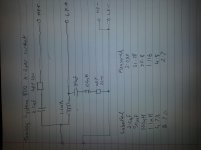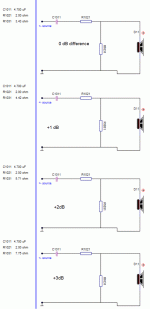I've been wondering about the TA of the Tannoy speakers. I don't have a way to measure my 8NFMIIs to see for myself.
But I have always heard Tannoy did a pretty good job with their passives.
But I have always heard Tannoy did a pretty good job with their passives.
Today I took the crossover apart, drew the schematic and checked the values of the components.

They all seem OK. The ESR of the 30uF cap measures at 0.12 ohms and the 2.2uF one is 0.02 ohms.
Right now I'm guessing the big notch is "by design" and I should put the whole mess back together and sell it quick, before I get tempted to start redesigning the crossover. 🙂

They all seem OK. The ESR of the 30uF cap measures at 0.12 ohms and the 2.2uF one is 0.02 ohms.
Right now I'm guessing the big notch is "by design" and I should put the whole mess back together and sell it quick, before I get tempted to start redesigning the crossover. 🙂
Well there's certainly nothing wrong with doing some basic measurements of the drivers and then simulating with them to see what you can come up with. If a new and improved xover is achievable with minimal parts, then you could always give it ago. You might be right though in that it is probably a better idea to sell them. The crossover is very simple and there isn't anything added to cause that notch, it's presence is most likely due to the nature of the driver and some weird cancellation effects that you're unlikely to be able to correct for.
The crossover frequency, with a design like this, is pretty much dictated by the directivity of the two drivers and how they match up. You could probably move this up to 2kHz, but I wouldn't go any higher. The cancellation effect occurs at around 1.6kHz and is obviously due to interactions between the tweeter and mid/bass as it goes away when the polarity is reversed. The only way to fix this would be to shift the xover frequency up a little, say to 2kHz, and then to go with a very steep xover, such as an 8th order acoustic affair. This will significantly reduce the overlap between the tweeter and the mid and help to eliminate the notch issue. This wouldn't be a simple fix.
Still that is all speculation. If it were me, I'd measure the drivers and see just what's going on. I'd simulate a little and if it appeared that the problem was intrinsic to the driver then I'd move on.
The crossover frequency, with a design like this, is pretty much dictated by the directivity of the two drivers and how they match up. You could probably move this up to 2kHz, but I wouldn't go any higher. The cancellation effect occurs at around 1.6kHz and is obviously due to interactions between the tweeter and mid/bass as it goes away when the polarity is reversed. The only way to fix this would be to shift the xover frequency up a little, say to 2kHz, and then to go with a very steep xover, such as an 8th order acoustic affair. This will significantly reduce the overlap between the tweeter and the mid and help to eliminate the notch issue. This wouldn't be a simple fix.
Still that is all speculation. If it were me, I'd measure the drivers and see just what's going on. I'd simulate a little and if it appeared that the problem was intrinsic to the driver then I'd move on.
Today I took the crossover apart, drew the schematic and checked the values of the components.
View attachment 452303
They all seem OK. The ESR of the 30uF cap measures at 0.12 ohms and the 2.2uF one is 0.02 ohms.
Right now I'm guessing the big notch is "by design" and I should put the whole mess back together and sell it quick, before I get tempted to start redesigning the crossover. 🙂
I know practically nothing about the Tannoy model in question but compared to every other Tannoy xover this schematic looks odd.
Usually you'd find the bypass/notch filter (made up of 30µF, 100mH and 2.7Ohm in this case) across the HF, not the LF.
Mmm, putting the notch on the tweeter would make far more sense as that would help to counter the typical rise you'd expect from the loading of the tweeter from the cone of the mid/bass.
Also the 2.2u cap on the tweeter seems oddly small. I don't suppose we know what the impedance of the tweeter is?
Also the 2.2u cap on the tweeter seems oddly small. I don't suppose we know what the impedance of the tweeter is?
It seems like the schematic is correct, after a bit of googling some stuff showed up other xover that were slightly different and others that were exactly the same.
Tannoy tweeters are nominally conical horns so they need an electrical response that rises at 6dB/oct from 3-5kHz upwards.
They usually use a tiny cap that rolls off from around 16-20k and use the notch to modify the slope so it has a flattish region from xover frequency up to where the 'boost' is needed.
This only works because the tweeter is 10-12dB more efficient than the woofer.
The notch makes no sense across the woofer IMO.
They usually use a tiny cap that rolls off from around 16-20k and use the notch to modify the slope so it has a flattish region from xover frequency up to where the 'boost' is needed.
This only works because the tweeter is 10-12dB more efficient than the woofer.
The notch makes no sense across the woofer IMO.
Thanks for the advice all. The tweeter DCR is 3.5 ohms and the woofer is 4.2.
I also agree it seems odd to have a 3kHz notch filter across the woofer, but I double checked the circuit and that is the way it is.
I also agree it seems odd to have a 3kHz notch filter across the woofer, but I double checked the circuit and that is the way it is.
I wish I could find the 8NFMII...and measurements.
I took the XO out of mine, and have a basic schematic drawn, but something is throwing me for a loop.
But that is for another thread I guess.
I took the XO out of mine, and have a basic schematic drawn, but something is throwing me for a loop.
But that is for another thread I guess.
I'm only guessing, but dark subjective character is probably also due to prominent low end seen in measurements in post 11. That could be due to the fact that System 800 is purpose made for positioning on the top of mixing desk where some canceling can occur at low frequencies. The rise is meant to compensate for that canceling. This kind of near fileld monitor is less than ideal for home listening at some distance.
Post 11 was a nearfield measurement, so there is a rise below 150Hz due to the baffle step. Tannoy published an on-axis response curve in the manual that looks flat.
After much head scratching and thoughts of redesigning the crossover, I decided to do just that. I figured it would fix the dark tonal balance and also help with the notch at 1500Hz by upsetting any cancellation that might be going on.
So far it seems to have been quite effective. The treble output is now similar to the Dynaudio speakers I'm using as a comparison.
So far it seems to have been quite effective. The treble output is now similar to the Dynaudio speakers I'm using as a comparison.
That's great. If you feel the speaker is a tad bright, try inserting a 0.47 ohm resistor or even a 0.22 ohm.
The only concern is that the filter transfer function for the tweeter is determined entirely by the impedance of the tweeter + the resistor combination. Removing the resistor is going to seriously affect the frequency response of the tweeter as well as altering the sensitivity.
If you want to try another xover then going with something like this would be a better idea.
The first schematic and component values will give you pretty much exactly the same response as the stock crossover, but it uses an lpad and gives the flexibility to increase the overall sensitivity.
The next three versions alter the value of the shunt resistance and maintain an almost identical transfer function, so will greatly assist in preserving proper driver integration.
If you want to try another xover then going with something like this would be a better idea.
The first schematic and component values will give you pretty much exactly the same response as the stock crossover, but it uses an lpad and gives the flexibility to increase the overall sensitivity.
The next three versions alter the value of the shunt resistance and maintain an almost identical transfer function, so will greatly assist in preserving proper driver integration.
Attachments
The only concern is that the filter transfer function for the tweeter is determined entirely by the impedance of the tweeter + the resistor combination. Removing the resistor is going to seriously affect the frequency response of the tweeter as well as altering the sensitivity.
But he is not obliged to keep 4,7uF, he can try different values of both the cap and the resistor.
I posted a schematic of the crossover earlier. I'm not too bothered about "maintaining proper driver integration" since as far as I can tell the drivers were not properly integrated to start with.
Subjectively the speakers sound better balanced in the room with the resistors bypassed. I did another frequency response measurement from the listening position, and it still shows that dip over about 1/2 octave centred on 1500Hz. Bypassing the resistor just seemed to lift the tweeter level a few dB with no major changes in the response shape.
I guess it's possible that the notch was always there and Tannoy just used 1 octave smoothing on their published frequency response chart.
Subjectively the speakers sound better balanced in the room with the resistors bypassed. I did another frequency response measurement from the listening position, and it still shows that dip over about 1/2 octave centred on 1500Hz. Bypassing the resistor just seemed to lift the tweeter level a few dB with no major changes in the response shape.
I guess it's possible that the notch was always there and Tannoy just used 1 octave smoothing on their published frequency response chart.
Last edited:
I did another frequency response measurement from the listening position, and it still shows that dip over about 1/2 octave centred on 1500Hz.
Try reversing the polarity of the tweeter and do another measurement. If the notch disappears, then the tweeter was connected out of phase.
- Home
- Loudspeakers
- Multi-Way
- Tannoy System 800 never sounded right
